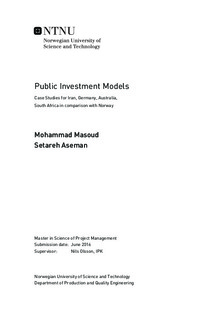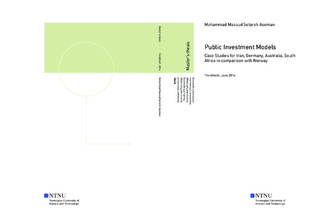| dc.description.abstract | This master project investigates public project governance frameworks with respect to cost estimation and user involvement aspects. The objective of this thesis is to understand the differences between governance frameworks for selected case studies and to compare them with the Norwegian appraisal model. The reason for this study is, first, to understand the differences and commonalities for cost estimation and user involvement in the early phase of public projects, and, second, to understand the effect of a framework on the project, which requires understanding of inner functions of the framework.
This master thesis comprises six chapters; each of them discusses the different parts of the topic that are required to fulfill the objective. Chapter one is an introductory part and highlights the background of the topic followed by the problem formulation and research objective as well as limitation and report structure employed in this thesis. In Chapter two, the relevant methodology that has been used in this report is explained. The methods for literature search and data collection as well as approaches that have been used to address the research questions and conclusion are also part of this chapter.
Chapter three is about the basic concepts and literature review. This chapter is divided into two parts and presents the skeleton of appropriate literature and concepts required for this thesis. Part One briefly describes the base concepts and perspectives about them (i.e. project, project management, life cycle of project, flexibility, uncertainty, and project models). Second Part looks upon more relevant concept for this thesis such as user involvement, governance, corporate governance, and cost estimation; moreover, it includes a brief description of cost estimation models, and describes different perspectives and findings that are relevant to address research questions of this study.
Chapters four and five focus on the results obtained for each individual case study through modeling them with respect to the base model (Norway), followed by analyzing and discussing these results in order to address the research questions precisely. The discussion part reach to different statement for each research question, the finding indicates that, achieving reliable early cost estimation in projects require, first the understanding of the corporate governance followed by effective implementation of available legislations with respect to functions for supporting the framework. Correspondingly, it provides the findings about the distinction in procedures and control mechanisms of estimation among all the cases explained by the methods and approaches each case has towards the controlling mechanism. Consensus that can be seen among the case studies is that reliable cost estimate is the main objective; however, there is a significant distinction in approaches and priorities, especially regarding the first steps. The last research question could be addressed by looking upon the role and type of user involvement in the early phases. While the mechanisms for involvement are similar, the approaches differ, i.e. there is a distinction with regard to priorities in sequencing the mechanisms, which, again, refers to the diversity of functions and means that framework finds suitable for its operation.
In Chapter six, the conclusion is drawn based on the foregoing chapters. The purpose and the intention of this master thesis could be achieved by comparing the selected case studies (Iran, Germany, Australia, South Africa) with the selected base mode, i.e. Norwegian appraisal model for public investment. This thesis concluded that introducing more legislations for improving cost estimation reliability is not an appropriate approach. This report rather strongly suggests that revising the available legislation and its efficient employment should be the first priority. In addition, to reduce the estimation bias in early phase, this report suggests the application of real time information through building information modeling (BIM) in the governance frameworks. This approach could significantly help to improve the estimation in early phase. Moreover it also looks suitable to control the multifaceted nature of governance and the biases in the estimation. | |

